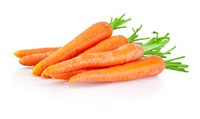Can You See A Vitamin?
 Description: Students will use chromatography to see the nutrients inside plants
Description: Students will use chromatography to see the nutrients inside plants
Purpose: To demonstrate the chemical make-up of food
Length of Activity: 90 minutes; this activity is best if split between two days
Materials:
- Vegetables, especially dark colored ones like spinach and carrots
- Small jars or glasses
- Covers for jars, either aluminum foil or plastic wrap
- Rubbing alcohol
- White paper coffee filters
- Shallow pan
- Hot tap water
- Tape
- Permanent marker / pen
- Plastic knife or spoon
- Plain white paper
Steps- Day One:
1. Give students vegetable matter to tear or cut into very small pieces and place each in its own small jar.
2. Have students label the jars with the name of the vegetable.
3. Add enough rubbing alcohol to each jar to cover the vegetables. SAFETY NOTE: Isopropyl rubbing alcohol can be harmful if mishandled or misused.
4. Using a plastic knife or spoon, carefully chop and grind the leaves in the alcohol.
5. Cover the jars loosely with plastic wrap or aluminum foil.
6. Place the jars carefully into a shallow tray containing 1 inch of hot tap water.
7. Keep the jars in the water for at least a half-hour, longer if needed, until the alcohol has become colored (the darker the better).
8. Twirl each jar gently about every five minutes. Replace the hot water if it cools off.
9. Let stand overnight.
Steps- Day Two:
1. Cut a long thin strip of coffee filter paper for each of the jars.
2. Label the paper using permanent marker/pen with the same name as on the jars so that they match.
3. Remove jars from water, dry off and uncover.
4. Place a strip of filter paper into each jar so that one end is in the alcohol. Bend the other end over the top of the jar and secure it with tape.
5. The alcohol will travel up the paper, bringing the colors with it. Observe the changes over approximately 30 minutes.
6. Remove the strips of paper and let them dry. Tape them to a piece of plain paper to analyze later.
What’s Going On?
This technique is called chromatography. Our dissolved plant matter separates as it travels with the alcohol up the filter paper. The more soluble parts of the plant matter travel farthest. If there are different colors on your filter paper then that indicates there are different kinds of molecules in your sample. The most soluble molecules are carotene- they will appear at the top as a yellow-orange. Other molecules you may see include xanthophyll (yellow), chlorophyll (green) and anthocyanin (red). Carotene and xanthophyll are carotenoids which break down further into vitamins in our bodies.